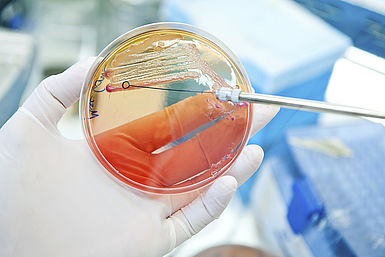Please type a search term (at least two characters)
News
EMPIR project develops a new method in the fight against antibiotic resistance

Bacteria don’t just exist as single cells but can congregate and form communities - this has implications for their antibiotic resistance
Bacteria are the most successful organisms on the planet and one estimate has calculated there could be upward of 1 trillion (1012) microbial species on Earth with 99.999 percent of these remaining undiscovered.
In Europe, antimicrobial resistance is responsible for approximately 25 000 deaths a year with annual treatment and social costs estimated at around 1.5 billion Euro. Two thirds of the deaths are caused by Gram-negative bacteria, so called as they fail to retain the crystal violet dye used in the Gram staining procedure. These bacteria have a double membrane and protein pumps that rapidly remove antimicrobial drugs that penetrate the membrane before they can take effect. In addition they can also attach to surfaces, such as implanted medical devices, and form dense aggregations called ‘biofilms’ which can be 100 times more resistant to antibiotics than singly growing, or planktonic, cells.
Analysis can be problematic as these ‘slimy’ films surrounding the bacteria contain high amounts of water which means that many high-resolution analytical techniques, such as Secondary Ion Mass Spectrometry (SIMS), can’t be utilised as they are vacuum based and require water free samples. However, dehydration leads to the 3D structure of such films being compromised meaning that information on how the bacteria are organised and resist treatment is lost.
The EMPIR project Quantitative measurement and imaging of drug-uptake by bacteria with antimicrobial resistance (MetVBadBugs, 15HLT01) has now taken the first steps to solving this problem. Using a combination of high-pressure freezing and 150 mM concentrated solution of ammonium formate as a cryoprotectant a technique was developed to allow imaging of biofilms in their near-native state using the powerful cryo-OrbiSIMS instrument.
Good practice guide free to download
Furthermore, project partner the NIBSC has produced a good practice guide on Cryogenic Sample Preparation for Vacuum Based Metrology Instruments which is free to download from the projects website. The scope of this guide is to provide information about cryo-fixation for vacuum-based metrology methods, allowing individuals to be able to produce reliable results, which are comparable across different laboratories.
The knowledge developed in the EMPIR project have now been transferred to the UK’s new National Biofilms Innovation Centre which will bring together researchers from multiple disciplines in the UK, across academia and industry, to prevent, detect, manage and engineer biofilms.
NPL’s Ian Gilmore, who pioneered the OrbiSIMS technology, said about the work
”Using the cryo-OrbiSIMS and cryo-sample preparation protocol we can see, for the first time, the three-dimensional distribution of key messenger quorum sensing molecules in the complex architecture of a Pseudomonas aeruginosa biofilm, which are responsible for many hospital acquired infections. This new insight will help improve antimicrobial treatments.”
This highly successful project, coordinated by Paulina Rakowska, resulted in 15 peer-reviewed publications. These achievements were possible through the close collaboration of the project consortium, drawn from Europe’s measurement institutes, universities and industries. Led by the National Physical Laboratory (NPL), the UK’s National Metrology Institute, the consortium included PTB, INRIM, the NIBSC, the University of Nottingham, BAM, CMI , LENS, GlaxoSmithKline Research and Development, Smith and Nephew, IONTOF GmbH and Specs Surface Nano Analysis GmbH.
As well as increasing our understanding on how bacteria resist treatment the methods developed in the project, such as how to disrupt lipid membranes, is also applicable to viruses like SARS-CoV-2, raising the possibility such techniques might be used for fighting bacteria and viruses.
This EMPIR project is co-funded by the European Union's Horizon 2020 research and innovation programme and the EMPIR Participating States.
Want to hear more about EURAMET?
Sign up for EURAMET newsletters and other information
Follow us on LinkedIn and Twitter
Carbon dioxide, released from man-made activities, is lowering the pH of the Earth’s oceans, and impacting the health of marine organisms worldwide more
Supporting automated and reconfigurable manufacturing systems more
Working with external project Cool White to test and suggest improvements on the locally available white paints more
The project FutureEnergy has provided new calibration services for ultra-high voltages and a good practice guide on Lightning Impulse dividers more
For many of the 5000 photonics companies in Europe a precise knowledge of a material’s optical properties is vital for industrial competitiveness more





